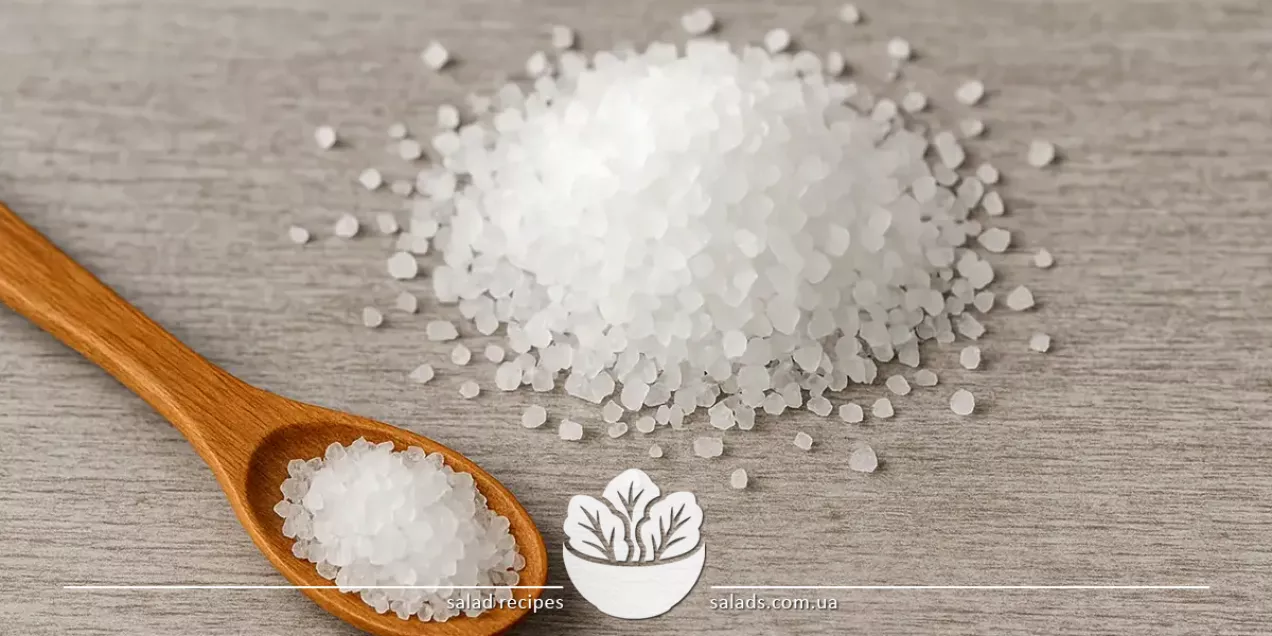
Table Salt

Table salt is the most common culinary seasoning, used in virtually every dish – from soups to desserts. Its main function is flavor enhancement, but it also affects dough consistency, vegetable preservation, and activates the natural taste properties of ingredients. Table salt has a fine crystalline structure and consists primarily of sodium chloride. You can explore other types of salt in a separate section.
Salad Recipes with Table Salt
The Role of Salt in Flavor Development
Salt is more than just a seasoning. It is a powerful flavor enhancer that activates taste receptors and reveals the aromatic qualities of food. Adding even a small amount of salt changes the perception of a dish: it becomes richer, more balanced, and allows sweet, sour, or spicy notes to be more noticeable. This is why salt is used not only in soups and side dishes but also in baked goods, desserts, and beverages. Salt also balances flavors – for example, it neutralizes excessive acidity in tomato sauce and highlights the natural sweetness of vegetables in stews. In meat dishes, salt improves texture and helps retain juices inside the product during thermal processing. Additionally, it aids in forming a delicious crust during roasting or frying. In cooking, salt is often combined with staple ingredients to deepen the flavor. For instance, it is traditionally used when boiling white rice, where it not only seasons the water but also improves the grain's texture, making it fluffier and more aromatic.
Origin and Processing of Table Salt
Table salt can come from various sources – it is obtained from seawater through evaporation or mined as rock salt from underground deposits. Rock salt is usually purified, ground, and sometimes enriched with additives to prevent clumping or for nutritional purposes (such as iodization). Sea salt contains additional trace elements, but table salt is the most commonly used due to its fine grind and convenience. On an industrial scale, salt goes through several stages of purification and grinding to achieve a fraction suitable for accurate dosing. Manufacturers often add anti-caking agents to prevent the crystals from sticking together during storage. Some types of salt are also iodized, which is recommended in regions where dietary iodine is deficient. In Ukraine, the most widespread type is fine-ground iodized cooking salt. Salt is a key component in many seasoning blends and marinades. For example, it is often paired with fresh garlic when preparing pickles, where it not only preserves the products but also enhances their flavor.
Salt in the Preparation of Various Dishes
Salt is used in nearly every culinary process – from boiling to baking. In meat, fish, legume, grain, or vegetable dishes, salt not only adds flavor but also acts as a texturizer: it affects protein density, softens fibers, and helps retain moisture. In soups, salt adds depth to the taste, while in stews it unifies ingredients into a harmonious composition. Salt plays a special role in baking: although used in small quantities, it balances sweetness, intensifies spice aromas, and improves dough structure. For example, in yeast dough, salt slows down yeast activity, promoting even rising. In batter for pancakes, pies, or bread, it highlights other ingredients and prevents over-salting through precise measurement. In traditional cooking, salt is combined with simple, accessible foods. A classic example is boiled beetroot, where a pinch of salt helps preserve the color and brings out the vegetable’s natural sweetness.
The Impact of Salt on Texture and Food Preservation
Beyond flavor, salt also influences the physical properties of food. In meat, it helps retain moisture, making it juicier after cooking. In fish, it acts as a natural preservative by slowing the growth of microorganisms. This is why salt has historically been used to preserve food before refrigerators were invented – it was used to cure fish, meat, vegetables, and cheese. In pickling, salt not only enhances flavor but also maintains texture – cucumbers stay crisp, cabbage remains firm, and tomatoes retain their juiciness. In cooking, salt is also used for pre-treatment: for example, eggplants are lightly salted before cooking to remove bitterness. Salt is often combined with other natural preservatives – for instance, with table vinegar when preparing marinades. Such combinations ensure reliable preservation and a rich taste without the need for artificial additives.
Salt as a Base for Blends and Seasonings
Salt is frequently used as a base ingredient in many seasonings and spice blends. Thanks to its ability to evenly distribute flavor, it helps balance other ingredients – dried herbs, spices, and powdered vegetables. Common examples include garlic salt, herb salt, curry blends with added salt, and marinade mixes for meat, poultry, fish, or vegetables. At home, salt is often mixed with dried dill, basil, paprika, thyme, or onion – this allows for creating custom all-purpose seasonings. These blends are used not only during cooking but also as a finishing touch – for example, for potatoes, salads, or snacks. In such combinations, salt helps regulate flavor intensity, making it either milder or more pronounced. It is also often used in the treatment of raw foods. For example, when rubbing meat before roasting, salt allows other spices to penetrate deeper into the fibers and also helps form a crispy crust during cooking. Due to its versatility, affordability, and effectiveness, salt remains a key ingredient in both home and professional kitchens.










